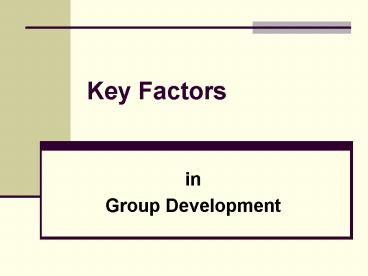Key Factors - PowerPoint PPT Presentation
1 / 21
Title: Key Factors
1
Key Factors
- in
- Group Development
2
Key Factors
- Commitment Group members see themselves as
belonging to a group rather than individuals who
operate autonomously. - Trust Group members have faith in each other to
honor their commitments, maintain confidences,
support each other, and generally behave in a
consistent and predictably acceptable fashion.
3
Key Factors
- Purpose The group understands how it fits into
the overall business of the organization. Group
members know their roles, feel a sense of
ownership, and can see how they make a
difference. - Communication Communication refers to the style
and extent of interactions among/between members
and those outside the team as well as the way
members handle conflict, decision making, and day
to day interactions.
4
Key Factors
- Involvement Everyone has a role in the group.
Despite differences, members must feel a sense of
partnership with each other. Contributions are
respected and solicited, and a real consensus is
established before committing the team to action. - Process Orientation Once a group has a clear
purpose, it must have a process or mean to get
there. The process should include problem-solving
tools, planning techniques, regular meetings,
meeting agendas, and minutes, and accepted ways
of dealing with problems.
5
Stages of Team GrowthForming
- Feelings
- Excitement, anticipation
- Pride in being chosen
- Tentative attachment
- Suspicion, fear, anxiety about job ahead
- Behaviors
- Attempts to define task
- Attempts to determine acceptable team behavior
- Decisions on what is needed
- Abstract discussions of concepts and issues
- Discussions of problems not necessarily relevant
to the task - Complaints about organization
6
Stages of Team GrowthStorming
- Feelings
- Resistance to tasks and methods of work
- Sharp fluctuations in attitude about teams
chance for success
- Behaviors
- Defensiveness and competition
- Questioning the wisdom of those who selected
project and team - Establish unrealistic goals
- Concerns regarding excessive work
- Creation of pecking order leading to tension
and jealousy
7
Stages of Team GrowthNorming
- Feelings
- Sense of team cohesion
- Acceptance of membership in the team
- Relief that everything will work out
- Behaviors
- Attempt to achieve harmony by avoiding conflict
- More friendliness, confiding in each other
- New ability to express criticism constructively
- Establishing and maintaining team ground-rules
and boundaries
8
Stages of Team GrowthPerforming
- Feelings
- Insights into personal and group processes
- Satisfaction at teams progress
- Close attachment to team
- Behaviors
- Constructive self change
- Ability to prevent or work through group problems
9
Processes Systems
- Textbook Adoption
10
What is a Process?
- SIPOC
- Suppliers
- Inputs
- Process Steps
- Outputs
- Customers
- Diagram on page 4-4 4-5
11
Thinking Processes!!
- Profound change that occurs when you begin to see
tasks as a related serious of activities. - Common understanding of what jobs are and how
they are linked. - Improves effectiveness by asking such questions
as - What is the purpose of this process?
- What do we have coming into the process?
- What must we do to get from one step to the next?
- Which steps are unneccesary?
- Where do we run into problems?
12
What is a System?
- A group of related processes
- Organizations are systems designed to serve
customers. - Campus example (teaching class)
- List the processes that have to happen before
first day of class
13
Process Management
- Operational Definitions
14
What Is an Operational Definition?
A definition that gives communicable meaning to a
concept by specifying how the concept is measured
and applied within a particular set of
circumstances. A precise definition that tells
how to get a numerical value for the
characteristic you are trying to measure.
15
Why Should a Team Use Operational Definitions?
- Put a workable definition to everyday
terminology - Eliminate misunderstandings
- Aid in data collection
16
Elements of anOperational Definition
- Criterion Standard against which to evaluate
results of the test - Test Procedure for measuring a characteristic
- Decision Determination whether test results
show the characteristic meets the criterion.
17
Developing anOperational Definition
- We want a 50 wool blanket.
18
Is this what we want?
Cotton
Wool
19
How would we write a clearer definition?
- Criteria - Wool fibers evenly distributed
comprise half the blankets weight. - Test - Analysis of samples measures
distribution proportion of fibers. - Decision - Wool fibers evenly distributed
comprise half the weight. Blanket is 50 wool.
20
Developing anOperational Definition
- Decision ______________________
- _______________________________
- Test __________________________
- _______________________________
- Criterion ______________________
- _______________________________
- ____________________
21
Operational DefinitionExercise 1
- An auto body shop manager was conducting a
training session on preparing a metallic surface
for painting, stressing the requirement that the
surface must be rust-free. Operationally define
the term rust-free. - Criterion
- Test
- Decision
22
Operational DefinitionExercise 2
- A quality improvement team at a medical clinic
pharmacy was attempting to improve its process by
making prescription service as fast as possible.
Operationally define the term fast in this
context. - Criterion
- Test
- Decision
23
Text Book Adoption Process
- What is the process?
- Everyone is involved in one or more parts of
process - Homework assignment
- What is your part in the process?
- SIPOC
- Describe, either words or diagrams or both
- Do we need Operational Definitions?
- Next week we will create a flow chart































